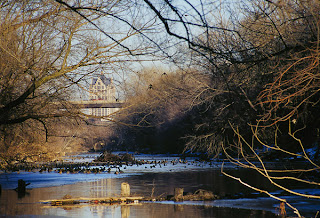The flowers began arriving soon after Lynn’s mother died, overnight delivery to our door. Some went to Lynn’s office. One especially lavish arrangement seemed a vast mountain of white, with bulbous hydrangeas, white roses, white carnations, and hundreds of daises. It would have made Lynn’s mother cringe. Lee was an austere, no-nonsense private woman. Her will stipulated that there be no formal funeral. She didn’t want to be fussed over.
Coincidentally, one of the flower arrangements, a simple basket of purple mums in pots that could be planted—very pragmatic; Lee would have approved—had been ordered from Barb and Dick’s Wildflowers. That is how Barb of Barb and Dick’s learned of Lynn’s loss. We’ve come to know Barb well through our many forays onto the Milwaukee County Grounds where she tends the Monarch Trail as lovingly as she does her flower arrangements.
Shortly after receiving the mums I found a small basket left on our porch. Instead of flowers this one contained only a few hazelnut twigs, twisted and bare. Hanging from the topmost twig were three bright green pupas with tiny golden dots. They looked fake: too perfect, as if made of plastic.
Lynn thought at first they were a decorative memorial. When I told her they were the genuine article and soon would become Monarch butterflies she was as enthralled as I was. It was the perfect condolence gift.

Though a bit reclusive, Lee lived an active life. She and Steve, her husband, had traveled extensively. Three years ago they had recently returned to their home in Tucson from an annual trip to Switzerland when she was struck down without warning with the stroke-like symptoms of acute encephalitis. She was rushed to the hospital where she lay unconscious, shrouded in the cocoon of the medical establishment. The prognosis was dire. A mosquito-bourn disease, viral encephalitis can lie dormant for decades, but when it attacks the brain stem it is usually fatal.
Our friend Barb had collected tiny monarch eggs, no larger than mustard seeds, from our favorite urban wilderness, the County Grounds. She gathers them regularly from areas that are soon to be mowed. After hatching Barb nurtures the caterpillars, feeding them the milkweed they prefer. We did not witness these stages. Nor did we see the spinning of the chrysalis when the caterpillar folded, then bound itself, instinctively preparing for the unfathomable metamorphosis to come.
No one saw encephalitis coming. But, against the odds, Lee did survive. The miracle of modern medicine kept her alive, in a coma. The doctors didn’t ask if Lee believed in miracles. When the breathing tube had to be removed and the irrevocable decision made whether or not to put her on a ventilator for life support, Steve, knowing her wishes, said no. She survived without it. For a brief period, it seemed like a miracle indeed. She recovered enough to walk with assistance and to fly to Wisconsin to live near family. But she was often confused and didn’t always recognize the people who knew her well. It wasn’t long after that when she began a long, slow decline….
We set the basket with the three pupas on a counter near a window. The sun glinted on the shiny green casing. Tiny gold spots twinkled like miniature brass buttons. We watched for the slightest change. After about a week one of them began to fade. The next day it was black instead of green. It was happening. In another day, the shell had become transparent. We could see all folded up inside the orange and black patterns that would become wings. When the pupa was opaque it was impossible to imagine a butterfly inside such a tiny package; but now we could see it curled up inside, like a magic pill. We could see it but it still didn’t seem real.

For three years Lee lived in a wheelchair and was cared for by Steve. Before the onset of the disease she’d been sharp, confident, sometimes cantankerous and often cynical. Now she was cheerful and pleasant. She smiled easily at visitors with an uncharacteristic twinkle in her eyes. But though she could hear the slightest whispers, her soft, almost demure replies sometimes made little sense. She spoke in non-sequiturs. She was physically present, but no longer the same wife, mother, person that the family grew up with. Gradually she became weaker. When she died the grief was tempered with an unnamable feeling, something between relief and compassion. In a way she had died three years ago. The intervening time was a period of waiting and transformation. A life-long atheist, her death would not lead to heaven or hell; it was a final stage; it was release, letting go.

The morning we saw the first butterfly hanging, immobile from the topmost twig seemed like another miracle. It loomed, enormous beside the breached, whitened shell of its chrysalis. Its wings hung limply, damp. I coaxed it onto my finger and took it outside, placed on a milkweed leaf. It quickly scuttled underneath to hang upside down, waiting for its wings to stiffen enough for flight. I never saw it fly. When I looked again, it was gone. The next day we had another butterfly, another miracle. How marvelous! How natural; to think this happens every day somewhere is to understand that life – all life – is a cycle of transformations. The final stage makes way for new life.
The following day the last butterfly clung to the underside of the branch; another white chrysalis flung open beside it. No less marvelous than the others. I took it out in the bright autumn sun to watch it fly away.




















































